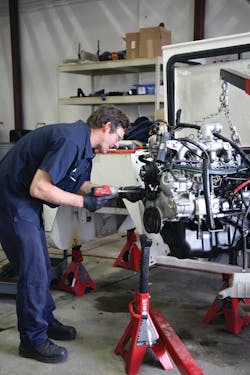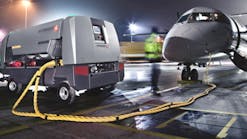Restoring Military GSE To ‘Fully Mission Capable’ Condition
Since 1951, Howell Instruments, Ft. Worth, TX, has built a reputation largely in the OEM market developing products that have helped improve the safety and performance of aircraft.
The company’s current chief well remembers some words of advice that the company founder gave him after he joined the company in 1998.
“He told me that I always needed to remember that Howell is an engineering firm with a manufacturing capability,” says Arthur “Shep” Brown, the company’s chief executive officer. “Our expertise has always been in engineering and designing and manufacturing whatever the customer needs,”
Over the years, the company has built cockpit instrumentation, jet engine trimmer, test sets and engine monitoring systems, and branched out to include MRO work for aerospace industry from its 117,000 sq. ft. headquarters that includes engineering, manufacturing and production facilities. Traditionally, however, much of this work was on the company’s own equipment.
Brown, however, knew the company had the know-how to do other such work.
Considering the military background of the company’s founder, it’s not surprising that much of the work for the past 60 years has been focused on the needs of the military market. (For more, see our sidebar, “History Of Howell”). In addition, take a look at the bios for the company’s current roster of leaders at the Howell Web site, and it’s plain to see the strong military backgrounds bring with them.
Brown, for example, was a veteran of aircraft maintenance and intercontinental missile operations with the U.S. Air Force. During his tenure with the USAF, Brown served alternately as course supervisor for the USAF aircraft maintenance officers’ course, responsible for training all Air Force active duty/reserve/guard maintenance officers. Brown was promoted to vice president of field engineering in 2001, and was named CEO in 2012.
While the company had done some refurbishment work on military GSE before, they recently took that business up a consider degree with a contract earlier this year to “reset” or refurbish some 100 pieces of GSE returning from service in Afghanistan and Iraq.
Originally, the company was tasked only to “facilitate” and outsource much of the reset work. But after quarterbacking some repair quotes and long lead times, company officials realized the work could be better done by bringing the reset operation in-house.
THE OBJECTIVE
In short order, the company was charged with the following:
- Evaluate and fully inspect 94 pieces of GSE.
- Estimate costs for parts and labor.
- Restore each item to “fully mission capable” condition.
- Test all work.
- Arrange for transport as necessary.
And when we say “short order,” we mean get up and running to finish the mission in 30 days.
With military operations in Iraq officially over and winding down in Afghanistan, plenty of soldiers are returning home and so is all the assorted equipment needed to back up our armed forces.
Whether it’s a consequence of the Great Recession or sequestration, there has been a change in how the country’s Defense Department spends its funds.
“I think that some of the dollars available to buy new equipment just aren’t there anymore,” Brown explains. “Therefore, everyone has to try and reuse the existing equipment.”
The company had more than its military pedigree to back it up. As Brown has noted, the company possesses the full capabilities to make whatever is needed to reset GSE.
“Sometimes we'll get involved in a component that we can’t replace and the simple fact is we have several engineers here and we have a machine shop with full CNC capability,” Brown adds. “If we can't get the original part, we can reconstruct it and redesign it ourselves here. There are not a lot of GSE repairs stations that have regular manufacturing capabilities like we do.”
From its headquarters, Howell is essentially a one-stop show for MRO-modification, maintenance, inspection and repair of aircraft and GSE:
- Engineering, repair and production capability to support obsolete and/or out-of-production parts.
- On-site modification, maintenance, inspection and repair of equipment.
- Low or high-volume parts production and repair.
- Rapid prototyping and rapid repair and production capability.
In addition, Brown also had a ready ally in colleague John W. Shipman, Howell’s vice president of operations.
A veteran of the U.S. Navy, Shipman gained extensive training and management experience during his tenure serving alternately as a department supervisor and master training specialist, responsible for hands-on training as well as writing comprehensive course curriculum for trainees.
Shipman joined Howell in 2002 as a programmer analyst and moved quickly through the ranks based on leadership, strategic planning and program management skills. He was promoted to manager of information technology in 2003, operations manager in 2008, and his current position in 2012.
“John has the talent to take on an unknown situation and put some organization around it,” Brown says.
GAP ANALYSIS
Once tasked with the job, Shipman set out to complete a gap analysis. In management parlance, gap analysis describes the difference between current capacity – “what is” and potential performance – “what needs to be.”
As we’ve mentioned, Howell had to get up and running to reset almost 100 pieces of GSE within 30 days of winning the contract.
“We probably had 90 percent of the solution based on the gap analysis,” Shipman says, “and we went out and found the other 10 percent.
While the company had plenty of advantages starting out, Shipman quickly determined that it was lacking the manpower with the technical expertise to go to work on diesel engines, generators and all the other myriad mechanical and electronic components to reset the GSE.
Shipman spent quite a bit of time going through resumes, interviewing candidates and looking for the right mix of capable people that would continue our level of customer support and quality of work.
He estimates he sifted through 60 resumes to hire six mechanics.
“We just don’t hire a warm body because they can turn a wrench,” Brown adds. “We have a good deal employee longevity and company history here and this is a family-oriented company because it's privately owned. Even though we appear to be much larger than we are, it's still pretty much a small company.”
As the hiring process progressed, however, the company also needed to plan on where to physically locate the new hires inside the kind of space they would need to do their jobs. After review, the company converted 6,800 sq. ft. of existing factory space at its Ft. Worth facility into a dedicated shop space filled with specialized tools and equipment to do the work.
MOVING DAY
At same point as all this progressed, it was moving day and time for the real work to begin.
As readers can readily tell from the photos that accompany this cover story, most of the equipment looks essentially the same as any other type of GSE stationed at a commercial airport ramp. Here’s a new acronym to explain why: COTS or “commercial off the shelf.”
The military is buying more and more commercially available products with much less specialized product designed to military specs that led to infamous $500 toilet seats in the past.
The Army, for example, primarily uses helicopters for much of his air power. But Brown and Shipman told us what most people don’t realize: The Army uses quite a diverse assortment of fixed-wing aircraft, too.
“Most of this aircraft are King Airs and Beech craft, for example,” Brown adds. “These commercial aircraft have obviously always been serviced by commercial GSE. “And much of the Army’s fixed-wing operation have to be fairly flexible in order to go to many placed in the world. As a result, the Army tries to build a mission profile around easily available commercial GSE.”
Howell’s marketing plans are to continue to promote this resetting expertise to other branches of the military for what stands to be a large market for fixing up used military GSE. Currently just a third of the way through this first contract, the work has already been expanded and extended.






